
The Battle of Passchendaele, also known as the Third Battle of Ypres, was a campaign of the First World War, fought by the Allies against the German Empire. The battle took place on the Western Front, from July to November 1917, for control of the ridges south and east of the Belgian city of Ypres in West Flanders, as part of a strategy decided by the Allies at conferences in November 1916 and May 1917. Passchendaele lay on the last ridge east of Ypres, 5 mi (8.0 km) from a railway junction at Roulers, which was vital to the supply system of the German 4th Army. The next stage of the Allied plan was an advance to Thourout–Couckelaere, to close the German-controlled railway running through Roulers and Thourout.
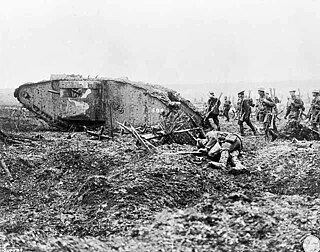
The Western Front was the main theatre of war during the First World War. Following the outbreak of war in August 1914, the German Army opened the Western Front by invading Luxembourg and Belgium, then gaining military control of important industrial regions in France. The tide of the advance was dramatically turned with the Battle of the Marne. Following the Race to the Sea, both sides dug in along a meandering line of fortified trenches, stretching from the North Sea to the Swiss frontier with France, which changed little except during early 1917 and in 1918.

The Menin Gate Memorial to the Missing is a war memorial in Ypres, Belgium, dedicated to the British and Commonwealth soldiers who were killed in the Ypres Salient of World War I and whose graves are unknown. The memorial is located at the eastern exit of the town and marks the starting point for one of the main roads out of the town that led Allied soldiers to the front line. Designed by Sir Reginald Blomfield and built by the Imperial War Graves Commission, the Menin Gate Memorial was unveiled on 24 July 1927.

A salient, also known as a bulge, is a battlefield feature that projects into enemy territory. The salient is surrounded by the enemy on multiple sides, making the troops occupying the salient vulnerable. The opponent's front line that borders a salient is referred to as a re-entrant – that is, an angle pointing inwards. A deep salient is vulnerable to being "pinched out" through the base, and this will result in a pocket in which the forces in the salient become isolated and without a supply line. On the other hand, a breakout of the forces within the salient through its tip can threaten the rear areas of the opposing forces outside it, leaving them open to an attack from behind.
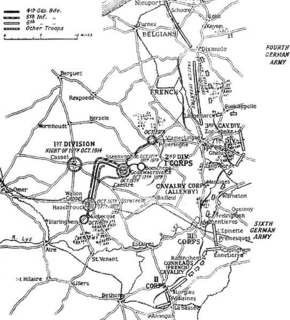
The First Battle of Ypres was a battle of the First World War, fought on the Western Front around Ypres, in West Flanders, Belgium, during October and November 1914. The battle was part of the First Battle of Flanders, in which German, French and Belgian armies and the British Expeditionary Force (BEF) fought from Arras in France to Nieuport on the Belgian coast, from 10 October to mid-November. The battles at Ypres began at the end of the Race to the Sea, reciprocal attempts by the German and Franco-British armies to advance past the northern flank of their opponents. North of Ypres, the fighting continued in the Battle of the Yser (16–31 October), between the German 4th Army, the Belgian army and French marines.
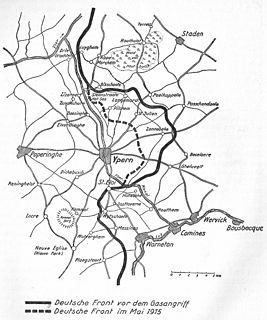
During World War I, the Battle of Ypres 1915 was fought from 22 April – 25 May 1915 for control of the strategic Flemish town of Ypres in western Belgium. The First Battle of Ypres had been fought the previous autumn. The Second Battle of Ypres was the first mass use by Germany of poison gas on the Western Front. It also marked the first time a former colonial force defeated a European power in Europe.

Sir Horace Darwin,, was an English civil engineer and a Fellow of Trinity College, Cambridge.
In the geologic timescale the Ypresian is the oldest age or lowest stratigraphic stage of the Eocene. It spans the time between 56 and 47.8 Ma, is preceded by the Thanetian age and is followed by the Eocene Lutetian age.

Polygon Wood is a forest located between Ypres and Zonnebeke, Belgium.

RE Grave, Railway Wood is a Commonwealth War Graves Commission (CWGC) memorial and war grave located in the Ypres Salient on the Western Front. It is located on the Bellewaerde Ridge near Zillebeke, about 4 kilometres east of Ypres, and a little north of Hooge. The area of the Cambridge Road sector, halfway in between Wieltje and Hooge, was the site of intensive underground fighting in the First World War. The Liverpool Scottish Memorial, Railway Wood is located nearby.
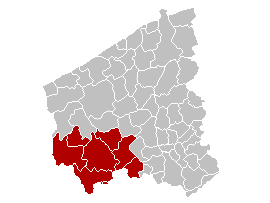
The Arrondissement of Ypres is one of the eight administrative arrondissements in the Province of West Flanders, Belgium. It is both an administrative and a judicial arrondissement. However, the Judicial Arrondissement of Ypres also comprises the municipalities of Staden and Moorslede in the Arrondissement of Roeselare.
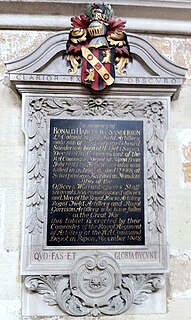
Ronald Harcourt Sanderson was an English rower who competed in the 1908 Summer Olympics for Great Britain. He was killed in action during the First World War.

Menin Road South Military Cemetery is a Commonwealth War Graves Commission burial ground for the dead of the First World War located near Ypres, on the Western Front.

Woods of Ypres were a Canadian doom metal band from Windsor, Ontario. The band was founded in 2002, initially consisting of three members: David Gold, Aaron Palmer and Brian McManus. Their lineup frequently changed afterward, with over 20 members in the band through its various incarnations, which saw operations later based out of Toronto from 2003-2007, and Sault Ste. Marie from 2008-2011. Their only constant member was multi-instrumentalist and frontman David Gold, with the band ending after Gold's death in December 2011, just before releasing their album Woods 5: Grey Skies & Electric Light, which won the 2013 Juno Award for the Metal/Hard Music Album of the Year.
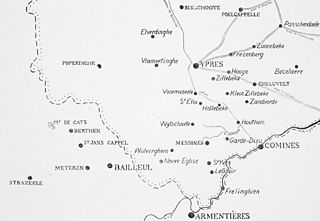
The Battle of Messines was fought in October 1914 between the armies of the German and British empires, as part of the Race to the Sea, between the river Douve and the Comines–Ypres canal.
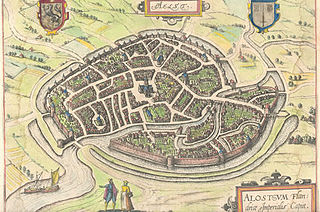
The Capture of Aalst of 1584, also known as the Betrayal of Aalst, took place in early February, 1584, at Aalst, County of Aalst, Flanders, during the Eighty Years' War and the Anglo-Spanish War (1585–1604). In 1584, after the successful Spanish military campaign of 1583, the Governor-General Don Alexander Farnese, Prince of Parma, was focused in subjecting by hunger the cities located on the Scheldt and its tributaries. One of these cities was Aalst, located on the Dender river. In January, the garrison of Aalst, composed by English troops under the command of Governor Olivier van den Tympel, was completely surrounded and blocked by the Spanish forces led by Parma. In this situation, the English soldiers, tired of the lack of supplies and pay, finally surrendered the city to Parma, in exchange for 128,250 florins and entered the service of the Spanish army.
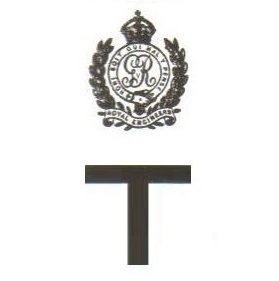
The 177th Tunnelling Company was one of the tunnelling companies of the Royal Engineers created by the British Army during World War I. The tunnelling units were occupied in offensive and defensive mining involving the placing and maintaining of mines under enemy lines, as well as other underground work such as the construction of deep dugouts for troop accommodation, the digging of subways, saps, cable trenches and underground chambers for signals and medical services.

In World War I, the area around Hooge on Bellewaerde Ridge, about 2.5 mi (4 km) east of Ypres in Flanders in Belgium, was one of the eastern-most sectors of the Ypres Salient and was the site of much fighting between German and Allied forces.
















